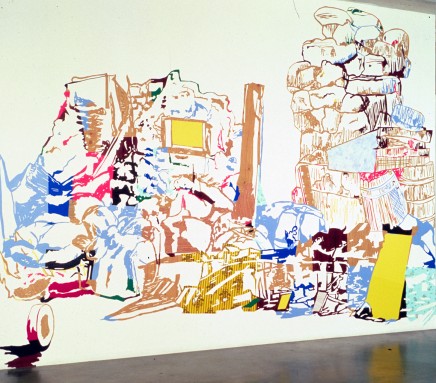
Santiago Cucullu Barricades from All D&D, Haiti, Prague that Fall, Fermin Salvochea (2003) Contact paper on wall.
Even a week after returning from the West Coast I'm still finding pieces of paper reminding me of things I wanted to write about. One of them is the wonderful wall installation we spotted on our way out of Los Angeles's Hammer Museum after visiting the exhibition, "Made In Mexico."
Although not on the scaffold at the time, Santiago Cucullu was still in the midst of installing a large temporary mural (not the work shown above) at the top of the main staircase, assembled from large sheets of all kinds of contact paper. I first noticed it when coming from behind the installation. I spotted a single section of cerulean blue hologram paper on the corner of a wall. I'm sucker for those papers, which give the uncanny impression you're looking into three dimensions and this one was gorgeous. But even incomplete as it was, Cucullu's piece was of course far more breathtaking. In its early form I assumed it was totally abstract. In fact, like much of his work it reads as both abstract and representational.
An excerpt from notes on the Museum's site:
Cucullus mural-scale drawing for the Hammer Museum is perhaps his most ambitious and freewheeling contact paper work to date. Its source imagery is almost comically disparate: some comes from the archives of the Federación Libertaria de Argentina (FLA), an anarchist library in Buenos Aires; other parts reference a drawing the artist made while in school (and subsequently lost) that depicted a pair of Doc Martens with the imagined name Dusty Springfield Rhoades written across the top; and still other fragments allude to Dusty Rhodes, a real-life reporter from Springfield, Illinois, whose name the artist came across coincidentally while listening to a radio report about a police officer dismissed from her force. Cucullu presents everything as a tangle of images on a nearly flat picture plane, which can lead almost to the point of visual abstractionmaking it hard to see the trees for the forest, so to speakbut also calls to mind pre-Renaissance religious paintings, which often set down multiple narratives in a single space on a single canvas.
[image from the Hammer Museum and courtesy of Julia Friedman Gallery]